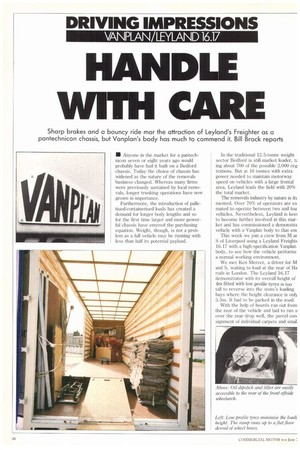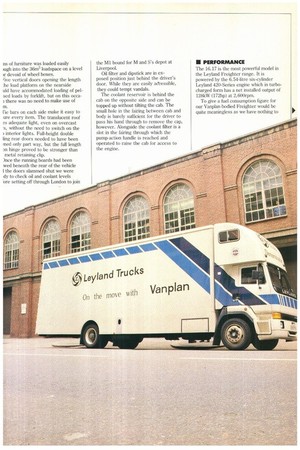HANDLE vinTH CARE
Page 34

Page 35

Page 36

If you've noticed an error in this article please click here to report it so we can fix it.
Sharp brakes and a bouncy ride mar the aftraction of Leyland's Freighter as a pantechnicon chassis, but Vanplan's body has much to commend it. Bill Brock reports
• Anyone in the market for a pantechnicon seven or eight years ago would probably have had it built on a Bedford chassis. Today the choice of chassis has widened as the nature of the removals business changed. Whereas many firms were previously sustained by local removals, longer trunking operations have now grown in importance.
Furthermore, the introduction of palletised/containerised loads has created a demand for longer body lengths and so for the first time larger and more powerful chassis have entered the purchasing equation. Weight, though, is not a problem as a full vehicle may be running with less than half its potential payload. In the traditional 12.5-tonne weight sector Bedford is still market leader, ti ing about 700 of the possible 2,000 reg trations. But at 16 tonnes with extra power needed to maintain motorway speed on vehicles with a large frontal area, Leyland leads the field with 20% the total market.
The removals industry by nature is fn mented. Over 70% of operators are es mated to operate between two and fou vehicles. Nevertheless, Leyland is keel to become further involved in this market and has commissioned a demonstra vehicle with a Vanplan body to that enc This week we join a crew from M ar S of Liverpool using a Leyland Freightt 16.17 with a high-specification Vannlan body, to see how the vehicle performs a normal working environment.
We met Ken Mercer, a driver for M and S, waiting to load at the rear of Ha rods in London. The Leyland 16.17 demonstrator with its overall height of 4m fitted with low profile tyres is too tall to reverse into the store's loading bays where the height clearance is only 3.5m. It had to be parked in the road.
With the help of boards run out from the rear of the vehicle and laid to run u over the rear drop well, the parcel con signment of individual carpets and smat
ns of furniture was loaded easily iugh into the 36m3 loadspace on a level devoid of wheel boxes.
■ ive vertical doors opening the length the load platform on the nearside old have accommodated loading of pelsed loads by forklift, but on this occai there was no need to make use of m.
Fie bars on each side make it easy to ure every item. The translucent roof ss adequate light, even on overcast 's, without the need to switch on the interior lights. Full-height double ling rear doors needed to have been !ned only part way, but the full length :in hinge proved to be stronger than metal retaining clip.
)nce the running boards had been wed beneath the rear of the vehicle the doors slammed shut we were dy to check oil and coolant levels ore setting off through London to join the M1 bound for M and S's depot at Liverpool.
Oil filter and dipstick are in ex posed position just behind the driver's door. While they are easily actessible, they could tempt vandals.
The coolant reservoir is behind the cab on the opposite side and can be topped up without tilting the cab. The small hole in the fairing between cab and body is barely sufficient for the driver to pass his hand through to remove the cap, however. Alongside the coolant filter is a slot in the fairing through which the pump-action handle is reached and operated to raise the cab for access to the engine. compare it with, because the vehicle was only part laden and as we are unlikely to repeat this route. However, in previous tests of a fully-laden flatbed version it returned 23.7 lit/100km (11.91mpg) over CM's regular motorway/A-road route of 338km (210 miles) compared with 25.02 lit/100km (11.29mpg) for the 16.170 MAN, 23 lit/100km (12.28mpg) for Mercedes-Benz 1617 and 22.85 lit/100km (12.36mpg) for a powerful Cummins LIOengined Ford Cargo.
After some difficulty in engaging second gear from rest we drew away from the kerb. With so little weight, acceleration is lively, but in heavy London traffic we were content to use third, fourth and occasionally fifth gear.
On the motorway the engine works hard to maintain the maximum legal speed. At Keele on the M6, where we encountered one of the steepest inclines on the trip, the gradient reduced our speed to 88 km/h (55mph).
• DRIVEABILITY The air-assisted clutch is light and makes repetitive gearchanging crisp and effortless.
Integral power steering makes light work of weaving in and out of traffic, even with the small Freighter steering wheel, but owing to its long 6.06m wheelbase and 10.8m body with long rear overhang, the vehicle needs to be treated with some caution. An improved steering lock would improve slow speed manoeuvrability. The audio signal which accompanies the use of the direction indicator is lost in engine and transmission noise.
Visibility from the driving seat is good and heated rear view mirrors give a good view past the full-width 2.5m body.
The driver's seat is firm and supportive with ample adjustment, but the dual passenger seat is too narrow and the curved styling and frame of the seat squab proved to be uncomfortable.
Braking was executed with caution as response on our vehicle was ultra sensitive and we had no wish to damage the expensive cargo. Delicate items might not have survived too long anyway, without the detailed attention to packing, as the stiff steel suspension is not the most considerate. Any large bump in the road set the front end of the vehicle bouncing.
Initially, the slipstream from other Large-sided vehicles had an unnerving effect, but we soon came to expect a steering and suspension reaction.
• ACCOMMODATION In the cab stowage facilities are not overgenerous, but the tool box makes a convenient foot rest for the passenger and the shelf above the screen is useful for paperwork.
We were surprised at Ken's reaction to the instrumentation. We had regarded the T45 style instrument panel as modern and compact without being overcrowded. But Ken criticised it for this very reason. "There is too much going on all in the one place", he told us. We believe, however, it needs only time to recognise the function of each gauge at a glance.
The aerodynamic shape of the vehicle incorporates Vanplan's custom-built sleeper cab positioned above the Freighter day cab. Entry is through the roof of the driving compartment and necessitates standing on the dual passenger seat, which will inevitably becor soiled by wet or oily boots.
The sleeping area is carpeted, fully ii sulated and is fitted with sliding windom on both sides. Lights are fitted to both bunks and the top one folds away when not in use. Other equipment includes a sink and Webasto overnight heater. A thicker mattress would improve the sleeping arrangements.




























































